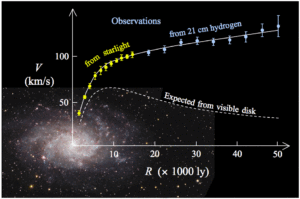
One of the earliest indications of the existence of dark matter came from an examination of the rotation of nearby galaxies. The study showed that stars orbit the galaxy at speeds that indicate there's more mass there than the visible matter would indicate. Now, researchers have taken this analysis back in time, to a period when the Universe was only a couple billion years old, and the ancestors of today's large galaxies were forming stars at a rapid clip.
Oddly, the researchers find no need for dark matter to explain the rotation of these early galaxies. While there are a number of plausible explanations for dark matter's absence at this early stage of galaxy formation, it does suggest our models of the early Universe could use some refining.
The measurements at issue here are what are called the "galaxy rotation curves." These curves track the speed at which stars rotate as a function of their distance from the center of the galaxy. If regular matter were all that was present, it would be easy to predict what we'd see. Close to the galaxy's center, stars would only feel a portion of the total galactic mass, so they would orbit at a relatively sedate speed. Any faster, and their orbits would shift outward.
Rotations would gradually speed up as you move outward and feel more of the galaxy's full mass, reaching a peak before tailing off again. That tail-off occurs because gravity's influence fades with distance. Too far out, and stars feel so little gravity that higher speeds would cause them to fly out of the galaxy entirely.

Measuring nearby galaxies, however, showed that this wasn't the case at all. The curves rose as you'd expect but didn't drop again. Instead, after rising a bit, stars' velocities stayed steady way out into the galactic hinterlands.
One explanation is that the visible matter in a galaxy occupies a small portion of the total galactic disk. The rest is filled out by dark matter, which extends much farther out. The gravitational influence of the dark matter explains why stars don't slow down at what appear to be the galaxy's outer edges—the outer edges are actually much farther out; they're just not visible. The influence of dark matter has also been observed in other cosmic phenomena since then, strengthening the case for its existence.
In fact, it's thought that dark matter catalyzed the formation of most galaxies. Simulations suggest that gravity draws dark matter into a web of filaments, and galaxy formation occurs primarily at the sites where these filaments meet. This explains why most galaxies we see today exist in clusters. Given this model, it's simple to assume that the condensation of dark matter into galactic disks preceded or ran in parallel with the production of the visible portion of the galaxies.
The new data would suggest otherwise. The authors took advantage of existing survey data to identify six large early galaxies that don't appear to have recently undergone a merger and have an abundance of stars. They are thought to be the precursors of galaxies such as our own and are already big enough to show a clean rotation curve. Their rotation was then measured using the red and blue shifts of light emitted by hydrogen, based on observations with the Very Large Telescope.
These rotation curves showed something unexpected: rather than remaining steady, velocities quickly tailed off as measurements moved away from the center of the galaxies. In fact, the curves looked a lot like what you'd expect based on the description above, if there were no dark matter around. Comparisons with models of galaxy behavior confirmed and quantified this idea: the curves could be reproduced using models that had a minimal dark matter component.
The authors checked a number of alternative explanations, like the gravitational influence of nearby galaxies or orbiting dwarf galaxies, but neither of these appeared to be a major factor. The drop in rotational velocity was also symmetric around the galaxy, which would seem to rule out localized influences. When the authors added local (and thus more current) galaxies to the analysis, the analysis showed that the faction of dark matter in galaxies seems to go down as you go further back in time.
It might be tempting to view this all as a problem for the idea of dark matter. But it's worth noting that the primary alternatives to dark matter, modified versions of gravity, wouldn't explain the situation either, as they suggest gravity changes over distance but not time.
The authors of the new paper see a number of possible explanations. One is that the early galaxies are very gas-rich, and these clouds of gas can experience local instabilities or collisions. This could cause the regular matter in the inner galaxy to compact, resulting in a normal-matter-dominated portion of the galaxy. The other possibility is that rather than forming the seeds of galaxies, dark matter starts off rather diffuse and takes time to form a disk-like structure that mirrors that of the visible galaxy. Either of these would explain the apparent matter dominance.
What about the simulations that show galaxies forming at the junction of dark matter filaments? The authors looked at these and found that they don't typically have the resolution needed to show what's happening in individual galaxies. So although these regions appear rich with dark matter, they can't tell us if that dark matter is condensing into disks at the same time as galaxies start forming.
All of which should be an invitation to the modelers to go for higher resolution simulations so that we can get some explanations for these dark-matter-poor galaxies.
Nature, 2017. DOI: 10.1038/nature21685 (About DOIs).
reader comments
121